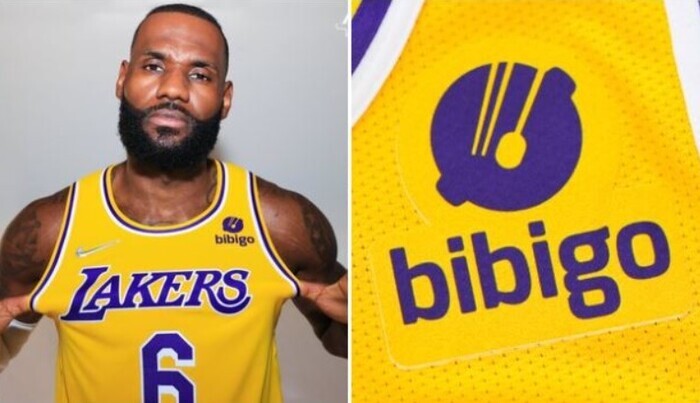hankyoreh
Links to other country sites 다른 나라 사이트 링크
From Choco Pies to hot-as-fire noodles, the world has developed a taste for Korean food

On YouTube, videos of people eating Korean “fire chicken” noodles (buldak bokkeum myeon) are spreading like wildfire. Meanwhile, US pro basketball stars are dribbling down the court in uniforms bearing the logo of the Korean food brand Bibigo.
Korean food has been expanding its scope at a fearsome rate. Not just in Asia but in Europe, the Americas, and throughout the world, Korean instant noodles, snacks, frozen foods, and more are in the limelight as anniversary gifts and party foods.
K-food is proving to be no longer just food for Koreans, with many products recording more of their sales overseas than in Korea.
Every year, overseas sales of Korean food are reaching new heights. A report on export trends in Korean food and beverage consumer goods published late last month by the Korea International Trade Association’s Institute for International Trade showed the 2021 dollar value of Korean food and beverage exports as of August totaling US$5,324,449,000 (around 6.3388 trillion won) — an increase of 16.3% from the same period in 2020. After crossing the US$7 billion mark last year, food and beverage exports appear poised to set a new record this year.
“As Korean as it gets”: Promoting spicy noodles and kimchiThe area that has stood out the most is ramyun, or instant noodles, a comfort food among Koreans. According to figures provided by the food and beverage company Nongshim, 690 billion won in domestic and overseas sales of Shin Ramyun noodles had been recorded as of the third quarter, with overseas sales accounting for 370 billion won of that.
It’s the first time in Shin Ramyun’s 35-year history that overseas sales have exceeded domestic sales. Nongshim is predicting that if the trend keeps up, it will have pulled in 930 billion won (US$783 million) this year from Shin Ramyun alone — with 500 billion won of that coming from overseas sales. This also means it’s getting close to surpassing a trillion won in annual sales of a single product.
Samyang Foods’ fire chicken noodles are another force to be reckoned with.
According to figures from Samyang, overseas sales of the noodles totaled 230 billion won as of the third quarter of 2021, or more than triple the 72 billion won in domestic sales. The biggest export market is China, followed by Southeast Asia and the US.
The boom is the result of a fire noodle YouTube challenge popular among young people around the world. With total sales of 648.5 billion last year, Samyang has been experiencing annual growth upwards of 100 billion won, thanks in large part to the success of their spicy chicken noodles.
Kimchi, the food most widely associated with Korea, has also been making noticeable strides.
Daesang’s Jongga brand, which ushered in the packaged kimchi era, has seen its exports more than double from US$29 million in 2016 to US$59 million last year. It accounts for around 40% of all Korean kimchi exports.
With the global spread of the COVID-19 pandemic, interest in the immunity boosting effects of kimchi as a fermented food have translated into an increase in sales.
In Russia and neighboring countries, Orion’s Choco Pies have become known as the “people’s snack,” while the scarcity of Paldo Dosirac instant noodles has even become a social issue in some parts of Russia.
The overseas K-food success stories are all the more meaningful because the products stick to their original Korean flavors.
Shin Ramyun products overseas preserve all the flavor that they are produced with in Korea. In the case of fire chicken stir-fried instant noodles, new items mixing carbonara and cheese flavors with the original spicy taste have captivated foreign palates.
“In over 40 countries in the Americas, Europe, and Asia, people are sharing in Korea’s most traditional flavors with things like cabbage kimchi, summer radish (yeolmu) kimchi, and ponytail radish (chonggak) kimchi,” said a Daesang official.

When Korean food exports began in the early 1970s, they were targeted at the overseas Korean market.
After launching its Shin Ramyun brand in 1986, Nongshim experimented with exporting it the following year. In 1996, it set up production plants in Shanghai and elsewhere. Ten years later in 2005, it expanded production beyond Asia with the establishment of a new base in Los Angeles.
Exports of Choco Pies, which have been such a huge hit in Russia, can be traced back to the early 1990s, and a purchasing boom among Russian merchants working chiefly out of Busan. In 1996, Orion set up an office in Moscow for full-scale exportation. Today, it is recording around 90 billion won in sales per year with 11 different Choco Pie varieties — far more than are available in Korea.
The success of the Paldo Dosirac brand dates back to Russian sailors docking at Busan’s port in the 1990s. Exports began in earnest after they told people back home about the instant noodles in square containers that were easy to carry in bags.
The start of Hallyu, or the Korean Wave, in the 2000s offered a new kind of opportunity.
The popularity of Korean TV series in other East Asia countries led to more viewers becoming interested in the food the characters ate, helping to create a craving for the Korean culinary culture on view there.
Since 2010, the K-pop boom has triggered a rise in the popularity of Korean foods around the world.
These days, the tteokbokki sweet and spicy rice cakes and fire chicken stir-fried instant noodles that BTS member Jimin eats in his online videos are a topic of interest among fans spanning from South America to Europe. Nongshim registered record sales of instant noodles thanks to the appearance of “jjapaguri” — a mixture of black bean (Chapagetti) and spicy seafood instant noodles (Neoguri) sometimes translated as “ram-don” — in the 2019 film “Parasite.”
From the Asian periphery, Korean food is now entering the mainstream in some of the world’s biggest countries. Bibigo, a brand under the CJ CheilJedang Corp., achieved the equivalent of more than 420 billion won (US$353.8 million) in sales in the US alone last year, putting it in first place in the dumpling market.
The company is also widely recognized by the public, with NBA superstar LeBron James and other LA Lakers players appearing in uniforms bearing the Bibigo logo.
Shin Ramyun, which was selected as one of the world’s top instant noodle products by the New York Times last year, has expanded throughout the US with sales at some 4,500 Walmart locations nationwide. Fire chicken noodles rank in the top ten instant noodle products sold on Amazon in the US.
“There had been a growing crisis in the Korean domestic market owing to the low birth rate and changing eating habits, but overseas markets have been a new land of opportunity,” said a source with Nongshim.
“With K-food being recognized as being delicious and healthy, we’re moving toward the day when people around the world enjoy Korean instant noodles and kimchi like they do pizza and pickles,” they said.
By Ock Kee-won, staff reporter
Please direct questions or comments to [english@hani.co.kr]

Editorial・opinion
![[Guest essay] Amending the Constitution is Yoon’s key to leaving office in public’s good graces [Guest essay] Amending the Constitution is Yoon’s key to leaving office in public’s good graces](https://flexible.img.hani.co.kr/flexible/normal/500/300/imgdb/original/2024/0416/8917132552387962.jpg) [Guest essay] Amending the Constitution is Yoon’s key to leaving office in public’s good graces
[Guest essay] Amending the Constitution is Yoon’s key to leaving office in public’s good graces![[Editorial] 10 years on, lessons of Sewol tragedy must never be forgotten [Editorial] 10 years on, lessons of Sewol tragedy must never be forgotten](https://flexible.img.hani.co.kr/flexible/normal/500/300/imgdb/original/2024/0416/8317132536568958.jpg) [Editorial] 10 years on, lessons of Sewol tragedy must never be forgotten
[Editorial] 10 years on, lessons of Sewol tragedy must never be forgotten- [Column] A death blow to Korea’s prosecutor politics
- [Correspondent’s column] The US and the end of Japanese pacifism
- [Guest essay] How Korea turned its trainee doctors into monsters
- [Guest essay] As someone who helped forge Seoul-Moscow ties, their status today troubles me
- [Editorial] Koreans sent a loud and clear message to Yoon
- [Column] In Korea’s midterm elections, it’s time for accountability
- [Guest essay] At only 26, I’ve seen 4 wars in my home of Gaza
- [Column] Syngman Rhee’s bloody legacy in Jeju
Most viewed articles
- 1[Guest essay] Amending the Constitution is Yoon’s key to leaving office in public’s good graces
- 2Faith the power of memory: Why these teens carry yellow ribbons for Sewol
- 3[Guest essay] How Korea turned its trainee doctors into monsters
- 4[Editorial] 10 years on, lessons of Sewol tragedy must never be forgotten
- 5US grants Samsung up to $6.4B in subsidies for its chip investments there
- 6[News analysis] Watershed augmentation of US-Japan alliance to put Korea’s diplomacy to the test
- 7How Samsung’s promises of cutting-edge tech won US semiconductor grants on par with TSMC
- 8Korea ranks among 10 countries going backward on coal power, report shows
- 9‘National emergency’: Why Korean voters handed 192 seats to opposition parties
- 10[Column] A death blow to Korea’s prosecutor politics